Interview with Ann Koeslag about the Black Sparrowhawk of the Cape Peninsula in South Africa
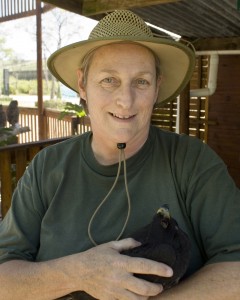 When you travel to southern Africa to look for raptors it is easy to focus mostly on either the large and spectacular like the Martial Eagle, the endemics like the Black Harrier or the really rare ones like the Taita Falcon. But that would be a mistake as the more common birds are equally fascinating – and not necessarily easier to find in the case of the Accipiters. We were hoping to see a Black Sparrowhawk and thanks to Ann Koeslog we got amazing views of this fascinating raptor (and also the Rufuos-chested Sparrowhawk). Ann has a research project going on about the Black Sparrowhawk and it was immediately obvious that she is very passionate about those birds. This is what research and conservation needs today – passionate people who really care about their work the the animals they study. We we were happy to have had the chance to spend a day in the field with Ann and I want to thank here very much for answering this interview questions.
When you travel to southern Africa to look for raptors it is easy to focus mostly on either the large and spectacular like the Martial Eagle, the endemics like the Black Harrier or the really rare ones like the Taita Falcon. But that would be a mistake as the more common birds are equally fascinating – and not necessarily easier to find in the case of the Accipiters. We were hoping to see a Black Sparrowhawk and thanks to Ann Koeslog we got amazing views of this fascinating raptor (and also the Rufuos-chested Sparrowhawk). Ann has a research project going on about the Black Sparrowhawk and it was immediately obvious that she is very passionate about those birds. This is what research and conservation needs today – passionate people who really care about their work the the animals they study. We we were happy to have had the chance to spend a day in the field with Ann and I want to thank here very much for answering this interview questions.
Markus Jais, Germany.
1) What is the “Black Sparrowhawk of the Cape Peninsula” project about?
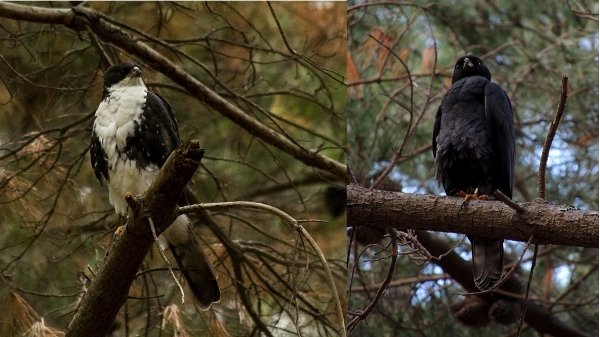
Until 2000 the Black Sparrowhawks were being studied in a piecemeal manner, but then a project was started on the Cape Peninsula to look at them more comprehensively. Subsequently, a student has started a Masters’ project at the University of KwaZulu-Natal in 2011 to look at these birds in that province. We are quite excited about what will be found, because the two areas (the Cape Peninsula and KwaZulu-Natal) have quite different habitats and different climate conditions.
The climate on the Cape Peninsula, which is the little crooked finger of land that sticks out into the Atlantic Ocean on the south-western tip of Africa, is very dry and windy in summer and cold and wet in winter. Because of this, the indigenous flora consists of low growing plants with only a few species of trees, which tend to be restricted to the occasional ravine, where there is a constant source of moisture.
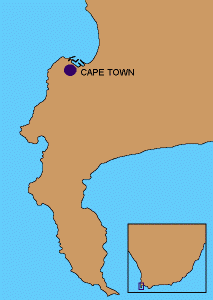
Like most of nature’s opportunists Black Sparrowhawks probably arrived once the plantations of pine and eucalyptus, which were planted on the Peninsula’s mountainsides during the mid-1900s, were tall enough to support their nests. They prefer the pines, but will use eucalyptus, poplar and black wattle (Acacia mearnsii), all of which are alien to South Africa, in preference to the indigenous trees.
They do nest in indigenous trees in areas of South Africa where there are large indigenous forests, but I get the impression that, mostly, they prefer pine trees.
Black Sparrowhawks are extremely adaptable and will live in practically any clump of trees, as long as the trees have suitable branches for their nests, and they deem the humans in the vicinity not to pose a threat. This is fortunate for them in a country where water is in short supply, and where natural forests are not common.
To give you some idea of the variability of nests, our highest is at 56 metres and the lowest at 3½ metres. The latter could be reached using the small ladder from my home when we went to ring the chicks. That tree was unfortunately cut down a little later by the owner of the property.


One of the first things we noticed about the Black Sparrowhawks on the Peninsula was the prevalence of so called “black morphs” in the population (see picture above). In the rest of Africa the birds are white from under their chins right down to their underpants, termed “white morphs” (See picture above). But on the Peninsula about 66% of the birds are black morphs. They can be totally black or have white throats, sometimes with white flecks on their chests and bellies. On looking into the matter it seems that the black morphs are fairly common up the east coast of South Africa, but very rare elsewhere.
2) What is the most common hunting method of Black Sparrowhawks?
They do not seem to hunt in the forests, but out in the fields, vineyards and urban gardens where they find their preferred prey. The female can take birds as big as Francolin and Guinea Fowl, but their commonest prey is pigeons and doves and a soupçon of smaller birds like starlings.
When hunting they tend to sit quietly in a tree waiting for birds to gather, and then to swoop down on them. Another strategy is to fly quite low over the ground in the hope of flushing a bird. They also sometimes attempt to catch pigeons or doves on the wing, but pigeons and doves are amazing long distance flyers and can generally out-fly and out-distance the Black Sparrowhawks; so why they attempt this form of hunting is a mystery. The Black Sparrowhawk is, we believe, at its best when swooping down on prey that is taking off from the ground or from a low perch.
3) What is known about the population trend and conservation status of the Black Sparrowhawk in South Africa?
The Black Sparrowhawk is considered not to be an endangered species, but, because their prey base includes chickens and pigeons, this regularly brings them into conflict with humans. So they are regularly persecuted, both in rural areas and towns. Although all raptors are protected in South Africa, policing their persecution is not taken seriously, probably because of a lack of resources.
Another problem facing these birds at the moment stems from their predilection to nesting in alien trees (especially pines), which are systematically being removed from conservation areas such as the Table Mountain National Park.
South Africa is at present in the throes of atlasing all the bird populations of the country. What it has shown for the Black Sparrowhawk is that their population appears to have grown, and that there has been a south-westward movement which is intriguing. Territories have been lost in the north-east of the country (e.g. Mpumalanga) but their range has expanded in the south-west (e.g. the South Western Cape). Between the first atlasing project (SABAP1 1987) and this one (SABAP 2), there is the same number of territories, but 50% of them have been lost in the north-east but gained in the south-west.
4) Do they also live in cities?
I am slowly coming to the conclusion that, although they do live in the wild, they are more numerous when living near human settlements. Their prey base of mostly pigeons and doves is most numerous near human settlements, which means that being close to people, the Black Sparrowhawks rarely have to search far for a meal. We have two breeding pairs which live right on the edge of central business district of Cape Town. The one nest is in a park, about 50 m from some very busy tennis courts and where every man and his dog wander around.
5) What are the difficulties when studying Black Sparrowhawks?
On the Cape Peninsula finding nests and monitoring them is reasonably easy. Luckily the birds are noisy during the breeding period, so in many instances we find them by their calls. About half the territories are found in the Table Mountain National Park and the rest in municipal greenbelts, golf courses, small holdings and private estates. Some of the territories occur in high crime areas and then personal safety (for the monitors) becomes a real issue. Luckily we have an enthusiastic group of volunteers who are always willing to band together for safety.
The other problem is that the birds are tree-nesting raptors. To place rings on chicks we therefore require the services of an experienced tree-climber who also knows how to handle the chicks. Mark Cowen is such a person, and has been one of the king-pins of this project. He is very inventive, safety conscious, and gentle when handling chicks.
6) What is the relationship with the Egyptian Goose and Pied Crows?
The Egyptian Goose population has increased enormously, both in numbers and in range. It came as quite a surprise to us that these traditionally ground-nesting water birds could wreak such havoc on a tree-nesting raptor.
Egyptian Geese are remarkably good parents and have long ago worked out the advantages of taking their eggs out of the reach of ground predators. Normally a flattened bed of reeds or grass lined with down from their breasts would be where they generally lay their eggs, but now they constantly try to evict raptors from their nests, to use them for their own eggs. A female Black Sparrowhawk has a mass of ~1000 g and a male of ~560 g. A female Egyptian Goose has a mass of ~1900 g and a male of ~2300 g. We have had a camera up at a nest recently and the fights between the hawks and geese have been vicious. The geese will fly full-tilt into the nesting raptor, to knock it right off the nest. The Sparrowhawk will then do the same to the goose, often with her talons out-stretched, which may or may not be successful. The camera has revealed that the geese will return several times a day to renew the attack, so that it is a wonder that the female Sparrowhawk can properly incubate her eggs, or that the eggs are not broken during the violence of the attacks. However, this camera was at only one nest where the female Sparrowhawk was eventually successful at hatching her eggs. We suspect that success of this sort is not very common.
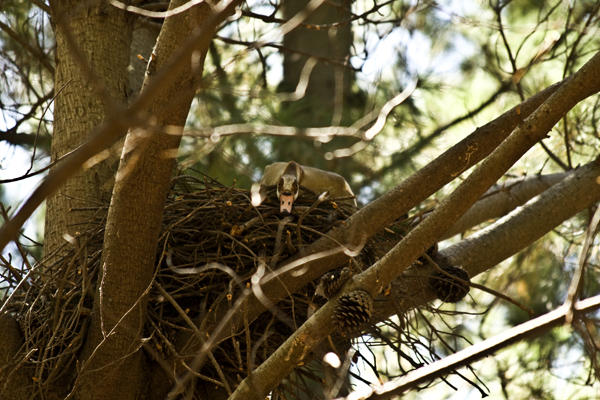
The other problem that all the birds face is the burgeoning Pied Crow population. In some areas the Black Sparrowhawks can have 40 – 60 of these birds constantly harrying them to steal eggs, chicks or incoming food parcels.
7) What is the breeding success of the pairs in your study area and the main influence of breeding success?
Over 10 years we averaged 1.5 chicks fledged per active nest per year. The Black Sparrowhawks in our area never have more than three chicks in a nest. Nests that are invaded by Egyptian Geese average 0.8 chicks per nest. The Black Sparrowhawks have developed various strategies to counteract the pirating of their nest by the geese. The most common strategy is to build alternate nests that they can to move to if they lose the one they are attempting to breed in.
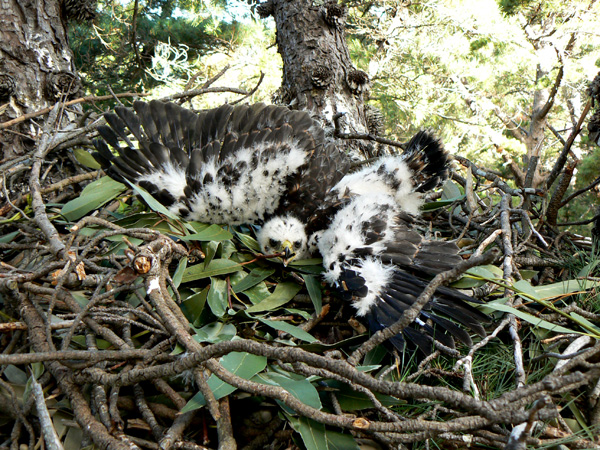
8) Is there competition with other raptors for nesting habitat?
We have found African Goshawks, Yellow-billed Kites, Buzzards (Buteo spp.), and Black Sparrowhawks all nesting in the one small stand of trees. No nest was further than 100 m from the other. This posed the problem for the adults having to remain constantly close to the nest during the nestling stage, to prevent predation of their off-spring.
9) Are Black Sparrowhawks sometimes eaten by other raptors, e.g. large owls or eagles?
We have never seen a case of an adult Black Sparrowhawk being predated by another raptor. On the other hand they are quite capable of taking out smaller raptors. Some of the prey remains we have found under the Black Sparrowhawk nests have been: Black-shouldered Kites, Rufous-chested Sparrowhawks, African Goshawk and Wood Owl.
10) What is known about the movements (migration, dispersal) of the species?
Our Black Sparrowhawks don’t migrate and they can sometimes be found in their nesting territories outside the breeding season. They are quite capable of hunting ~6 km from the nest even when they have chicks to feed. Finding them outside the breeding season is a problem because they are then generally silent, and usually not in the immediate vicinity of their nests. That they do not migrate is evidenced, however, by them being spotted hunting in suburban gardens, in much the same areas where they hunt during the nesting period.
They do however disperse to new territories, especially the juveniles who are seeking their own places to nest. The furthest we know of a ringed bird going is 64 km, but we would not be surprised to find them even further away.
11) What was your most amazing experience with Black Sparrowhawks?
In 2009 we were called out to a small holding one night because the resident nesting female had been rescued from a large concrete water storage container and seemed to be in poor condition. On examination we couldn’t find anything the matter with her except that she was cold and wet. After drying her out, she was stored in a cardboard box overnight. Mark, our climber was on hand, and he climbed to the nest and removed the two, two-and-a-half week old chicks for safety. They too were stored in a separate container to wait for morning.
I must mention that both parents are remarkably calm birds with a nest about 40 metres from the chicken run on this small holding. The owners of the property love having them there so do not interfere with them in any way. As a result the birds are not too particularly worried by us monitoring them.
The next morning we restored the chicks to the nest and released the female from her box. Both chicks, which we ringed that morning, subsequently fledged.
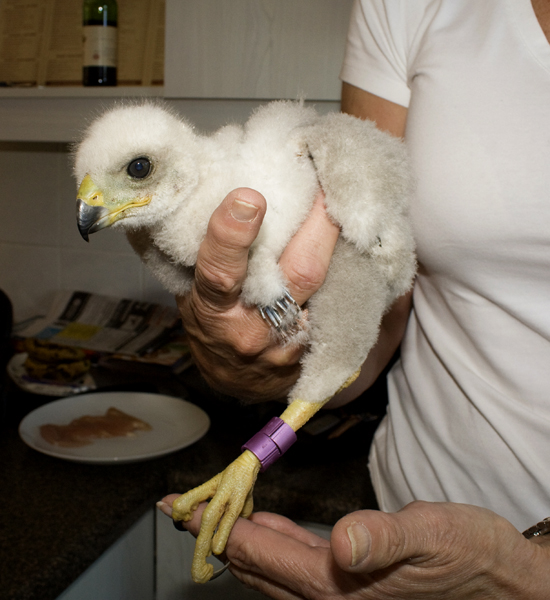
This year one of those chicks turned up at a territory (AT) 15 km from where she had fledged. She had turned into a black morph and was paired with a mature white morph male who, although not colour ringed, we recognise from his behaviour. Later on that morning we found her at another territory (CHF) about 800 m from the AT territory, also with an unringed white morph male in attendance. This male was very young judging by his eye colour. Just to make sure that we were not hallucinating we stationed one team at the AT territory and another at the CHF territory and within an hour established that she was moving between the two nests and had a male in residence at both.
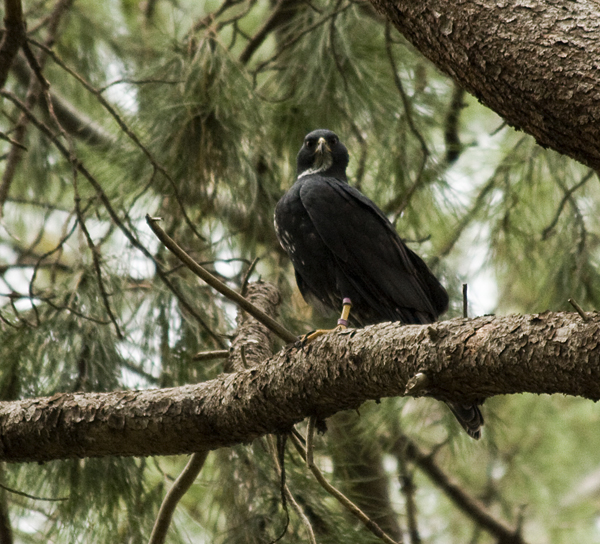
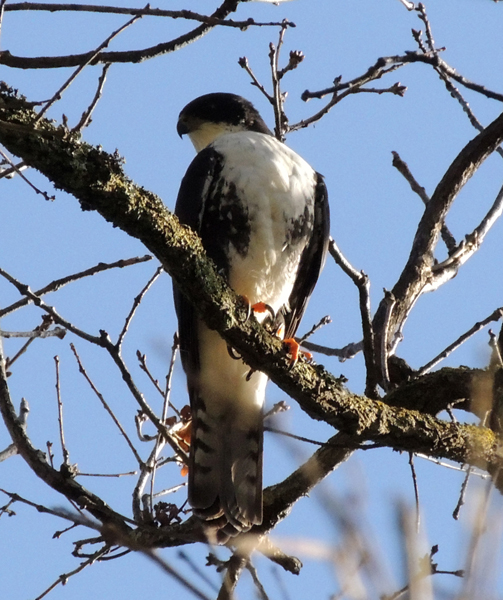
She eventually decided in favour of the younger male at the CHF territory and laid her eggs and settled in to incubate. At this point it was decided to install a camera at that nest. This particular nest is an anomaly, because instead of being on the main trunk of the tree it is a long way out on a limb. This makes it a particularly difficult climb for Mark because he cannot put any of his weight on the branch for fear of destroying the integrity of the nest. Using a series of higher branches he can get right next to the nest without disturbing it.
When he got up there, the female flared slightly but refused to leave her eggs. This is the first time this has ever happened in our experience. So for 50 minutes Mark worked around the nest and even spent some time sitting about 60 cm from the bird, who stayed put. At one point he moved his hand near her and all she did was show him her talons and as soon as he removed his hand she relaxed again.
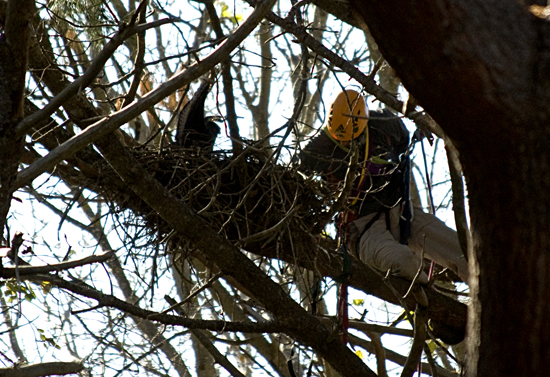
This is the bird that we have photographs of resisting constant takeover bids by Egyptian Geese during the course of one day, so she is not placid about protecting her nest.
A few days ago we went back to the nest to ring the chicks. I think the whole team were worried by the sort of reception the climber would encounter if the bird refused to leave her chicks. Mark got to the nest and was once again greeted by a bird which steadfastly refused to budge. She flared in protection of her chicks and struck Mark once in the face as a warning, but, as usual he took things very slowly and carefully, and after a few minutes managed to remove a chick from the nest. We decided to send one chick down at a time so as not to leave her with an empty nest. This worked well and both chicks were quickly ringed.
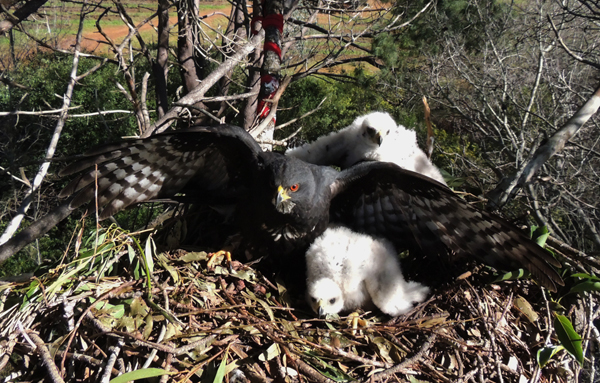
We have also taken note of the fact that she is still visiting the AT territory, and suspect that she is keeping any other females from using it. The story continues ………
We are constantly amazed at how each bird has its own personality. When we are ringing chicks some parent birds just go off and sit quietly in a tree nearby and keep an eye on what we are doing. Others get so furious that Mark occasionally is attacked by them. I don’t think that anyone can actively follow a creature’s life, recording its parents’ and grandparents’ lives without becoming totally besotted with them. This year we are monitoring ~45 nests so life is full of interest.


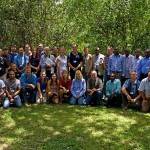

I saw a Black Sparrohawk yesterday (presumably one of the pair or offspring of the De Waal Park pair) take a feral pigeon on the wing, not more than 5 or 6 metres from me. The sparrowhawk just somehow insinuated itself into the wheeling flock of pigeons, descended to a bird lower down in the flock, extended talons and took the pigeon with no stress or struggle. I was in the shower on the second floor. S/He had been in the area for a while as we had seen the pigeons and starlings spook a few times, a fairly regular occurrence. It was remarkably undramatic and accomplished with the greatest of ease. My wife thensaw the ‘hawk on an djacent roof, one talon on her supper.
This morning I was fortunate to find a black sparrow hawk busy eating what I presumed was a pigeon on my back lawn. It was so exciting. Seemed a youngish but still large bird and I was unsure what it was. It was there for at least 2 hours. I took pictures with my phone but the zoom didn’t give me much detail and I did not want to disturb the bird so could not get any closer. We live near kloof st in tamboerskloof.
I have the privilege of a Crowned Eagle nest within view from our lounge window. The eagles are regularly “buzzed” by a Black Sparrowhawk, which I often hear among the trees. I have watched it chase down a dove on the wing. Spectacular! Cowies Hill, Westville, Durban, KZN.
Hi Anne – On 3 of the the last 4 days (oct 10 -13), early in the morning, we have had a Black Sparrowhawk quietly sitting on the neighbour’s roof. The local Guinea Fowl were pretty vocal about it’s presence. Ringed on the right leg silver over brown?
This morning 12 February 2015 ,for the second time we had a Black Sparr0whawk/black chested morph(melanistic), sitting on our birdbath a few meters away from the bird feeder. Bellville, Western Cape.
A black sparrow hawk is back in the tree where a nesting pair produced two chicks last year. I’m not sure if it is one of the chicks or one of the adults. Two more nests have appeared besides the original one.
I thought you might be interested to know that the Black Sparrowhawk is in Langebaan too. I found a Black Sparrowhawk nesting in a small woodland on a farm in Langebaan during one of my trail runs. I visit once a week and all is going well.
Hi Ann, for the last 3 days i’ve spotted 2 Black Sparrowhawks perched on a lamp post near Hospital bend over looking the grassland. i just found it weird seeing them 3 days in a row and about the same times 6:30am and 18:30.
100% Black chested bird (had been ringed) sitting on our fence in Lake Michelle, Noordhoek yesterday.